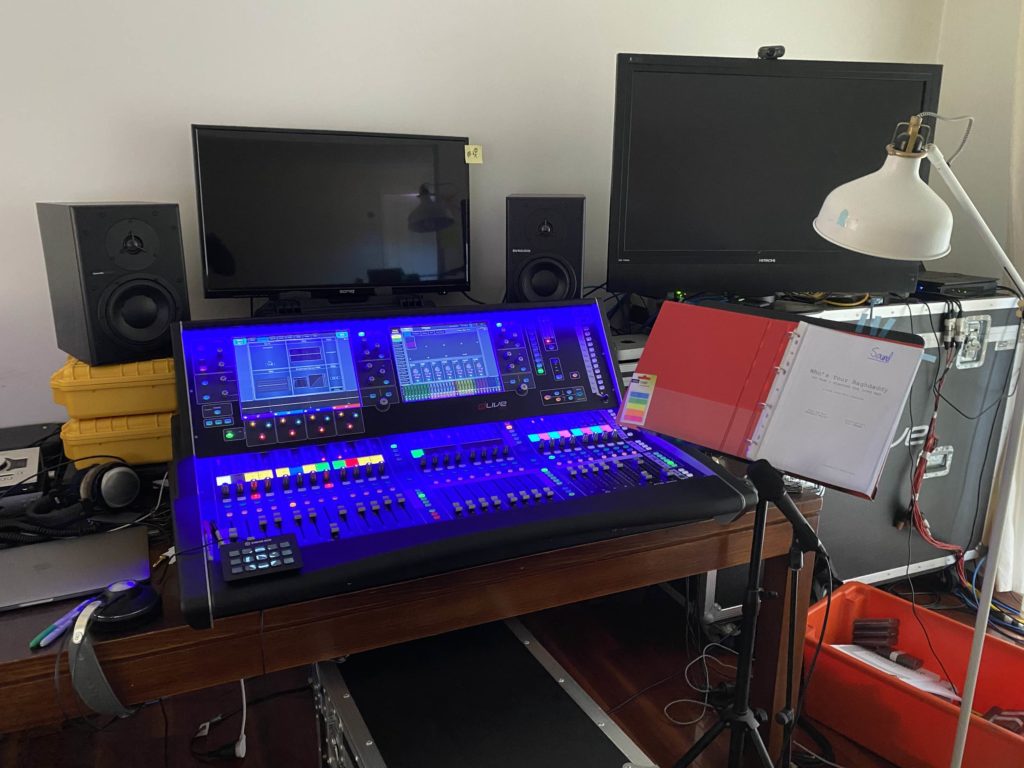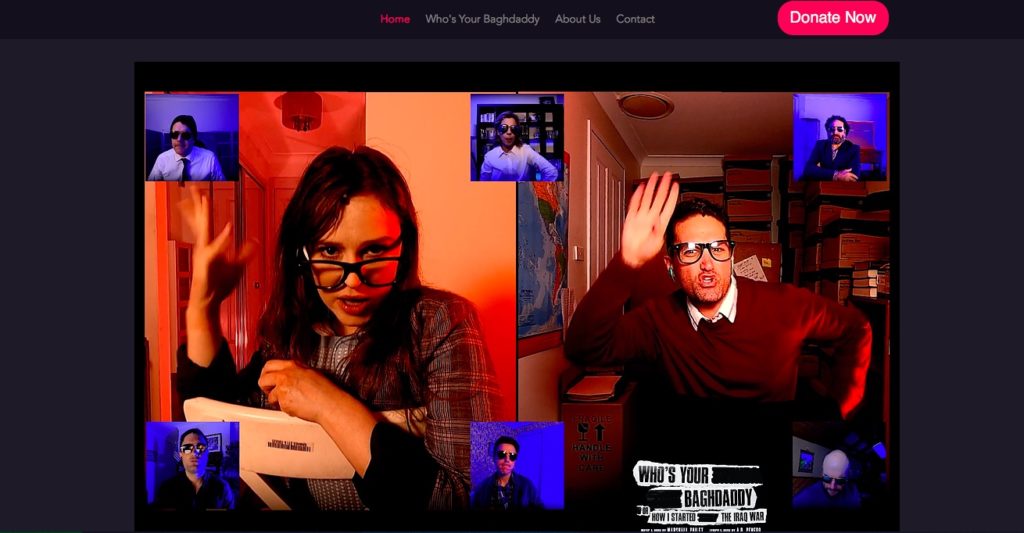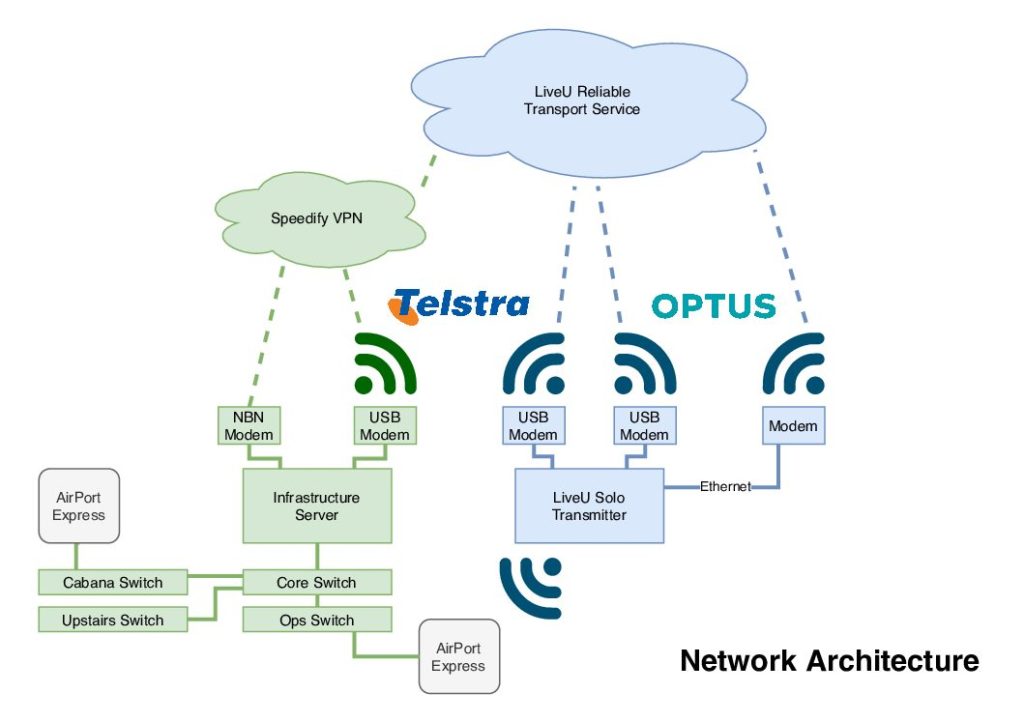News
10 Aug 2020
Australia’s First Live-streamed Musical

Subscribe to CX E-News
Pictured: Musical director Steven Kreamer
My company, Locimation, was engaged by producers Curveball Creative Pty Ltd to provide technical services for Australia’s first live online musical theatre performance.

The show was performed live five times, by a cast of eight, from the 24th to the 28th June. Originally intended to be staged at the Flight Path Theatre in Marrickville, the musical’s conceit of an “AA-style” support group meeting was adapted (as many real-world support groups have) to the format of a live-streamed Zoom call. The show – Who’s Your Baghdaddy (Or How I Started The Iraq War) – was directed remotely from New York by Neil Gooding.
Musical theatre productions have, thus far, been largely unable to be performed during COVID-19, due to the requirements of physical distancing, and the prohibitive latency introduced by video call platforms.
To meet both challenges, Curveball Creative hired an AirBNB in Roselands – able to accommodate all cast members in their own isolated rooms, and provide for direct cable runs to each – which was principally split into three zones: individual cast rooms, a central server location (akin to back-of-house), and an ops room (FOH – albeit, ironically, at the back of the house).
The largest challenge for the production was an economic one – in uncertain times and an experimental production, the technical budget was understandably constrained, turning the economic challenge into a technical one.
Consultations with industry heavyweights offering disguise, Watchout, or E2 systems came in at double to sextuple the production budget for the media server component alone, forcing a need for innovation, thrift and networking.
Curveball Creative’s production would not have been possible if not for the generous support of driveway hire vendors and the broader theatre community.
Video
Each room was outfitted with a GoPro Hero 8 (configured with Linear view and ProTune for fixed exposure and white balance) from RENTaCAM, an LCD monitor for video foldback (Beaches Productions), and Decimator MD-HX cross converter (Scene Change) to extend both the monitor and GoPro signals over SDI cabling (Action Sound) back to the media server.
Custom GoPro mounts were designed, 3D-printed and iterated onsite by Locimation using Fusion 360 and a Creality Ender 3 Pro. The media server itself was custom-built by Locimation for Beaches Productions, with a Blackmagic Quad 2 (8-input) SDI capture card – supplemented for the duration of the show by an additional Blackmagic Quad SDI card from Videomax. Several server software options were evaluated for capability and cost.
Ultimately, we settled on Arkaos MediaMaster Pro, utilising all 36 of its video layers for background and foreground camera layers, a constant camera multi-view, pre/mid/post-show slides, effect overlays, sound effects and video credits.
Its output groups were configured to provide for independent programming of an audience output (including countdown slides), foldback output (including standby messaging) and operations output (including camera multi-view).
Arkaos was controlled via six universes of unicast Art-Net from a multi-user MA2 OnPC system (Beaches Productions), programmed by Locimation, using interactive MA2 macros to quickly build Zoom-like speaker and grid views.
Most musical numbers tracked LTC timecode, provided via Dante from QLab out into an OnPC Wing, whilst the remaining tracks and cues accompanying dialogue were operated by the Production Stage Manager (Bridget James) using an additional laptop in the MA2 session.
A late addition to the video system design was a Blackmagic ATEM 2 M/E Production Studio 4K and ATEM 1 M/E Advanced Panel, which provided a fallback media player for a technical difficulties slide (thankfully never used), the embedding of the program output into the operations view via its SuperSource feature, and auxiliary switching for cast and operations monitors.

The ATEM’s program output was fed to a LiveU Solo (provided, alongside generous advice and insight, by Carlo Fornasari of Videomax), which transmitted to Wowza Streaming Cloud.
Due to the need for real-time ticket validation and session management, a custom streaming site (Amazon S3, Lambda, DynamoDB) was developed by Linus Karsai and Locimation, featuring custom integration with Ticketek Ignition and TicketSearch, live support chat (tawk.to) and analytics (Google).
To connect the director (Neil Gooding) with the cast during pre-production, we integrated Arkaos’ back of house feeds and sources with the new NDI capabilities of Skype for Creators. Neil was provided with an NDI feed of the audience view during rehearsals, alongside a Dante feed from the audio system.
Lighting
Phoebe Pilcher’s lighting design called for CreamSource key lights (provided by CreamSource), Chauvet Rogue R2 fill lights (Intense Lighting Hire) and ProShop LED PAR Quad-18 wall wash (Beaches Productions). Taylor Allen (TALX) provided an additional MA2 OnPC system and programming during tech week.
Once finalised, the MA2 video and lighting worlds were merged, and lighting cues were tied to video cues for ease of operation. DMXking eDMX PoE nodes were used for output, fed via sACN.
TALX also developed an MA 3D visualisation of the rooms in the house, laid out across individual virtual camera views, in order to aid programming whilst cameras were not visible in current cues or otherwise unavailable.
Audio
According to Dave Bergman’s design, each cast member was outfitted with a Sennheiser EW SK 500 G3 bodypack transmitter with DPA 4061 miniature omni mic, a Sennheiser EK 2000 IEM bodypack receiver with personal headphones, and each room with a condenser backup mic in case of bodypack failures.
An Allen & Heath dLive system (Beaches Productions) was split between a central location – housing the dLive DM64 alongside the Arkaos media server, Blackmagic ATEM switcher, and wireless mic / IEM racks – and ops (a dLive S5000 surface).
Audio was mixed for both broadcast and monitors by Dave Bergman, and later Courtney Weaver, providing individual stereo mixes to each cast member. The broadcast feed was merged into the SDI program output via the Blackmagic ATEM switcher’s XLR inputs, and monitored through the operations SDI feed.
A synchronisation video was integrated into the pre-show media server sequence in order to check for A/V sync and compensate for media server latency using the dLive’s output delay.
The dLive system also provided for talkback from production team members (the stage manager, choreographer, technical director, and lighting and sound operators) to each other and to the cast.
… in uncertain times and an experimental production, the technical budget was understandably constrained, turning the economic challenge into a technical one
Using Dante Virtual Soundcard, and a Skype connection to the director, Neil was able to provide notes directly from New York to the cast’s in-ears, and hear their questions back. Using the dLive Custom Control app, the stage manager was provided with a personalised iPad layout for talkback to individual members of the cast and crew.
Sound effects were triggered from the dLive console’s scene changes using Allen & Heath’s TCP MIDI driver and QLab, and returned to the console via Dante Virtual Soundcard. In addition to the dLive’s internal audio effects, a Logic Pro X session provided outboard processing via Dante.
The musical director Steven Kreamer’s backing tracks, including click, were also fed via Dante, and he was provided with an Allen & Heath IP-8 to control his headphone mix and talkback mics.
Network / Infrastructure
Internal systems management was provided by a QSC Q-Sys Core 110f running custom Locimation-developed Lua plugins in order to monitor:
- Sennheiser wireless systems for battery levels, RF signal strength, and audio signal loss or clipping via the Media Control Protocol and AES67 IP direct outs from the dLive,
- the CPU, GPU and memory usage of the Arkaos media server (using NSClient /NSCA),
- the presence of ArtNet at the media server (using NSClient / tcpdump),
- the presence of sACN on the network,
- the presence (via ICMP ping) of critical network devices including the dLive DM64 and surface, QLab laptops, MA2 operator stations, sACN output nodes, and ATEM switcher and surface, and the health of the Wowza Streaming Cloud stream (via their API).
The health of the media server was also reported to New Relic Infrastructure for analysis of trends / anomalies. A bespoke network configuration was designed and deployed by Locimation for the show, given the mission-critical role of networked technologies in its production.
HPE ProCurve (now Aruba) 2530 series switches were deployed with a DSCP-mapped strict priority queue QoS configuration and IGMPv2 snooping – as is typical for engineered Dante / AES67 networks – and rapid spanning tree for redundant switch links.
In order to maintain seamless Internet connectivity (for services other than the broadcast, which made use of the LiveU Solo’s dedicated 4G modems), we deployed the Speedify link aggregation service, spanning two 4G modems and the house’s own Telstra cable internet connection.
Lastly…
With the lessons learnt and systems developed for the show, Locimation and Beaches Productions are now making a packaged streaming system available for other productions with similar requirements. Locimation is also making its Q-Sys Lua plugins and switch configurations available under its open-source initiatives.
Curveball Creative is already planning future shows with the system, and has made a recording of one of the live performances of Who’s Your Baghdaddy (Or How I Started The Iraq War) available on-demand at www.curveballcreative.com.au
For further information, please contact:
Michael Goodyear
Director, Locimation Pty Ltd
Mob: 0431 953 515
Mail: michael@locimation.com
CX Magazine – August 2020
LIGHTING | AUDIO | VIDEO | STAGING | INTEGRATION

Entertainment technology news and issues for Australia and New Zealand
– in print and free online www.cxnetwork.com.au
© VCS Creative Publishing
Subscribe
Published monthly since 1991, our famous AV industry magazine is free for download or pay for print. Subscribers also receive CX News, our free weekly email with the latest industry news and jobs.
























